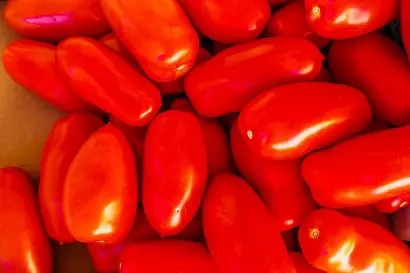You’ve probably heard the name before when you’re looking at recipes, or you might have seen the term labeled on the packaging and produce at the grocery store, but what exactly is a San Marzano tomato? Where are the real San Marzano tomatoes from?

San Marzano tomatoes are a particular variety of plum tomato that originates from a small town near Naples, Italy, called San Marzano sul Sarno. Although this was where the tomatoes were first grown, they are now grown commercially around the world.
Read on to discover more about this famous name and what makes these tomatoes so special.
Where Do San Marzano Tomatoes Come From?
There are some specific types of foods and drinks that are unique to the region in which they are made – like Champagne sparkling wine or Gloucester cheese. San Marzano tomatoes, however, can actually be grown almost anywhere.
The generic name refers to the specific variety, rather than the region in which every tomato has to have grown. Most San Marzano tomatoes are still grown in Italy, but the seeds themselves have been distributed to many different places and are now widely commercially available.
There is, however, a special kind of San Marzano tomato that is grown in the Valle del Sarno region where they originated, and these can be classified as “Pomodoro San Marzano dell’Agro Sarnese-Nocerino”. These are generally thought of as the “real” San Marzano tomatoes and can be distinguished by the EU “DOP” logo on the packaging.
In 2010, Italian police forces actually confiscated over 1,000 tonnes of canned tomatoes (worth more than 1,000,000 euros) that were labeled improperly.
There is a popular story that says the first San Marzano seed was brought to Campania in 1770 as a present to Naples from the Viceroyalty of Peru, where it was first planted in the soil around the famous Mount Vesuvius volcano.
What Kind Of Tomatoes Are San Marzano?
San Marzanos are “heirloom tomatoes”, which means that they are non-pollinated and non-hybrid. Heirloom tomatoes tend to be sweeter than hybridized varieties and they are often less red in color as they have not been genetically modified.
San Marzano tomatoes are also “plum tomatoes”, which are generally smaller and more oval or cylindrical in shape than other varieties.
Plum tomatoes usually handle packing and shipping better than other varieties, and they are commonly used in sauces and for preservation. For this reason, they are also known as “processing tomatoes” or “paste tomatoes”.
What Is Special About San Marzano Tomatoes?
So, we know where San Marzano tomatoes come from and what gives them their name, but what is it about this particular variety that made chefs so excited? Why are they considered to be the best of the best?
San Marzano tomatoes are widely favored for their tenderness, mild acidity, and rich flavor. They are also longer and thinner than most plum tomatoes, with fewer seeds and a more pulpy texture.
Of course, the flavor is important when you are cooking, but it’s not all about what hits the palate the hardest. Though you might not think it, tomatoes can actually be very acidic and strong, which often overwhelms the delicate undertones that you want to bring forward when you are cooking.
The mild acidity and balance that San Marzanos offer gives delicate nuance to dishes and is great for sauces of all kinds.
Are Canned San Marzano Tomatoes Good For Cooking?
You might think that fresh produce is always going to be the best way to go when you are cooking, but there is nothing wrong with reaching for a can of tomatoes – particularly when they are as delicious as San Marzanos.
In fact, most Italians will use preserved tomatoes and tomato paste in their everyday cooking. The flavor is still excellent, they are available all year round, and it takes a lot of the hassle out of the process.
If you do want to use San Marzano canned tomatoes, however, you should know what you are getting. You can buy many tomatoes grown from San Marzano seeds that can be given the San Marzano name, but you should look out for the “DOP” emblem if you want them straight from the source.
At the end of the day, all San Marzano tomatoes can be delicious, no matter where they were grown, but you might end up paying a premium for something that’s slightly less than authentic.
Can You Grow San Marzano Tomatoes In The US?
Although this particular tomato variety was first grown in Italy, you can find the seeds yourself almost anywhere in the world – and even grow some San Marzanos in your own backyard.
You might be surprised to hear that tomatoes were actually introduced to Italy from the Americas many years ago, which means that the US definitely has the right sort of climate to get a really good crop.
There are a few things that you will want to consider, though, if you’re hoping for a particularly healthy and delicious yield. San Marzano tomatoes like:
- Moist soil, which means consistent watering.
- Neutral water (pond water, well water, or rainwater is best).
- Full sun (6 to 8 hours daily).
- Temperatures of between 50 and 95 degrees Fahrenheit.
- Acidic to neutral soil of at least 60 degrees Fahrenheit.
Overall, they are not too difficult to cultivate, and they can become pretty big when they reach their full potential. San Marzano tomato plants generally grow to between 6 and 8 feet in height and between 2 and 3 feet in width.
Are San Marzano Tomatoes Worth The Price?
They may be quite special and unique, but is it really worth spending all that extra money on these tomatoes?
At the end of the day, it all comes down to your individual tastes. The beauty of these tomatoes is in their subtlety and balance, which may not matter as much when you’re throwing a lot of other ingredients into the mix as well.
If you’re not an expert chef that’s looking to produce the finest dish possible, then you might not notice the difference between a San Marzano can and any other high-quality preserved tomatoes.
If you want to see what all the fuss is about, though, then they’re definitely worth trying at least once.
- The Top Restaurants Specializing in Truffle Dishes - August 10, 2023
- Truffle Panna Cotta: A Decadent Dessert Recipe for Truffle Lovers - August 7, 2023
- Truffle Scrambled Eggs: A Luxurious Breakfast Delight - August 7, 2023








